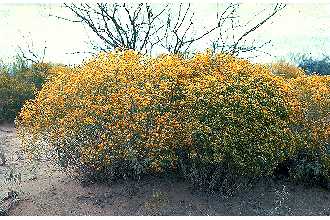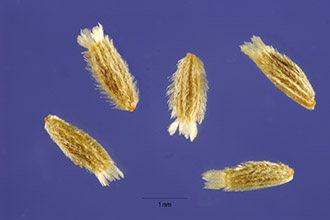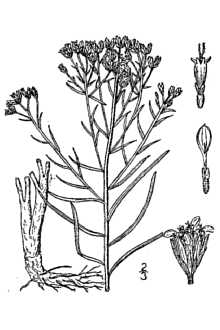Gutierrezia linearis Rydb.
Scientific Name: Gutierrezia linearis Rydb.

| General Information | |
|---|---|
| Usda Symbol | GULI3 |
| Group | Dicot |
| Life Cycle | Perennial |
| Growth Habits | Forb/herbShrub, Subshrub, |
| Native Locations | GULI3 |
Plant Guide
Alternate Names
snakeweed
Uses
Ethnobotanic: Broom snakeweed was used by numerous Native American tribes for a variety of reasons. The Blackfoot use the roots of broom snakeweed in an herbal steam as a treatment for respiratory ailments. The Dakota use a concentrate made from the flowers as a laxative for horses. The Lakota took a decoction of the plant to treat colds, coughs, and dizziness. The Navajo and Ramah Navaho rubbed the ashes of broom snakeweed on their bodies to treat headaches and dizziness. They also chewed the plant and applied it to wounds, snakebites, and areas swollen by insect bites and stings. The Comanche used the stems of broom snakeweed to make brooms for sweeping their residences. Wildlife: Broom snakeweed is utilized by some large ungulates including mule deer and pronghorn antelope. Broom snakeweed can comprise up to 28% of the pronghorn diet.
Status
Please consult the PLANTS Web site and your State Department of Natural Resources for this plant’s current status (e.g. threatened or endangered species, state noxious status, and wetland indicator values).
Weediness
This plant may become weedy or invasive in some regions or habitats and may displace desirable vegetation if not properly managed. Please consult with your local NRCS Field Office, Cooperative Extension Service office, or state natural resource or agriculture department regarding its status and use. Weed information is also available from the PLANTS Web site at plants.usda.gov.
Description
General: Sunflower Family (Asteraceae). Broom snakeweed is a perennial subshrub that ranges from 2 to 10 dm in height. It is native to the U.S. The stems are bushy and branch upwards from the woody base. The non-woody stems range from smooth to having some short hairs. The stems may be resinous and therefore sticky when touched. The leaves are alternate and range from linear to linear and threadlike in shape. The leaves are from 5 to 60 mm long and 1 to 3 mm wide. Dense clusters of flowers form at the ends of the stems. There are 3 to 8 ray florets per cluster and 2 to 6 disk florets per cluster. The flattened part of the ray corolla or ligule is yellow in color and 1 to 3 mm long. The whorl of bracts that is found at the base of the flower cluster is 3 to 6 mm tall and 2 mm across. The bracts are narrow and green in color at the apex and along the midnerve. The achenes have a modified calyx consisting of 8 to 10 acute scales. The acute scales of the ray achenes are about one-half as long as those of the disk achenes. Distribution: For current distribution, please consult the Plant Profile page for this species on the PLANTS Web site.
Adaptation
Broom snakeweed is found in open, dry plains and upland sites, Broom snakeweed is killed by fire, Re-establishment occurs via wind dispersed seeds, Broom snakeweed densities usually increase following fire, if the seeds in the seed bank are left undamaged by heat, Plant Materials <http://plant-materials,nrcs,usda,gov/> Plant Fact Sheet/Guide Coordination Page <http://plant-materials,nrcs,usda,gov/intranet/pfs,html> National Plant Data Center <http://npdc,usda,gov>
Establishment
Broom snakeweed flowers are pollinated by various insects. Regeneration occurs primarily through wind dispersed seeds. Most germination and seedling establishment occurs during the winter and spring. Broom snakeweed seeds are dormant at maturity and require a 4 to 6 month after-ripening period prior to germination. The most successful germination occurs between 59 to 86 °F, at or near soil surface. Broom snakeweed prefers full sun, well-drained soil, and low moisture.
Pests and Potential Problems
Grown in its native habitat and using local seed stock, broom snakeweed should not be prone to debilitating pests. Cultivars, Improved, and Selected Materials (and area of origin) These materials are readily available from commercial plant sources. Contact your local Natural Resources Conservation Service (formerly Soil Conservation Service) office for more information. Look in the phone book under ”United States Government.” The Natural Resources Conservation Service will be listed under the subheading “Department of Agriculture.”
Control
Please contact your local agricultural extension specialist or county weed specialist to learn what works best in your area and how to use it safely. Always read label and safety instructions for each control method. Trade names and control measures appear in this document only to provide specific information. USDA, NRCS does not guarantee or warranty the products and control methods named, and other products may be equally effective.
References
Austin, D.D. & P.J. Urness 1983. Overwinter forage selection by mule deer on seeded big sagebrush-grass range. Journal of Wildlife Management 47(4): 1203-1207. Carlson, G.G. & V.H. Jones 1940. Some notes on uses of plants by the Comanche Indians. Papers of the Michigan Academy of Science, Arts, and Letters 25:517-542. City of Boulder, Colorado 2001. Open spaces and mountain parks. http://www.ci.boulder.co.us/openspace/nature/garden s/grow-tip.htm Elmore, F.H. 1944. Ethnobotany of the Navajo. University of New Mexico Press, Albuquerque, New Mexico. 136 pp. Gilmore, M.R. 1913. Some Native Nebraska plants with their uses by the Dakota. Collections of the Nebraska State Historical Society 17:358-370. Hocking, G.M. 1956. Some plant materials used medicinally and otherwise by the Navaho Indians in the Chaco Canyon, New Mexico. El Palacio 56:146-165. Johnston, A. 1987. Plants and the Blackfoot. Lethbridge Historical Society, Lethbridge, Alberta. 68pp. Martin, S.C. 1975. Ecology and management of southwestern semidesert grass-shrub ranges: the status of our knowledge. RM-156. USDA Forest Service, Rocky Mountain Forest and
Range
Experiment Station, Ft. Collins, Colorado. 39 pp. Moerman, D.E. 1998. Native American ethnobotany. Timber press, Portland, Oregon. 927 pp. Moerman, D.E. 1999. Native American ethnobotany database: Foods, drugs, dyes and fibers of native North American peoples. The University of Michigan-Dearborn. http://www.umd.umich.edu/cgi-bin/herb. Smith, A.D. & D.M. Beale 1980. Pronghorn antelope in Utah: some research and observations. Publication No. 80-13. Utah Division of
Plant Traits
Growth Requirements
| Temperature, Minimum (°F) | -38 |
|---|---|
| Adapted to Coarse Textured Soils | Yes |
| Adapted to Fine Textured Soils | Yes |
| Adapted to Medium Textured Soils | Yes |
| Anaerobic Tolerance | None |
| CaCO3 Tolerance | Medium |
| Cold Stratification Required | No |
| Drought Tolerance | High |
| Fertility Requirement | Low |
| Fire Tolerance | Medium |
| Frost Free Days, Minimum | 140 |
| Hedge Tolerance | None |
| Moisture Use | Medium |
| pH, Maximum | 8.0 |
| pH, Minimum | 6.0 |
| Precipitation, Maximum | 30 |
| Precipitation, Minimum | 7 |
| Root Depth, Minimum (inches) | 16 |
| Salinity Tolerance | Low |
| Shade Tolerance | Intolerant |
Morphology/Physiology
| After Harvest Regrowth Rate | Slow |
|---|---|
| Toxicity | Slight |
| Shape and Orientation | Erect |
| Nitrogen Fixation | None |
| Resprout Ability | No |
| Active Growth Period | Spring and Summer |
| Bloat | None |
| C:N Ratio | High |
| Coppice Potential | No |
| Fall Conspicuous | No |
| Fire Resistant | No |
| Flower Color | Yellow |
| Flower Conspicuous | No |
| Foliage Color | Green |
| Foliage Porosity Summer | Porous |
| Foliage Texture | Coarse |
| Low Growing Grass | No |
| Lifespan | Moderate |
| Leaf Retention | No |
| Known Allelopath | No |
| Height, Mature (feet) | 1.5 |
| Growth Rate | Moderate |
| Growth Form | Single Crown |
| Fruit/Seed Conspicuous | Yes |
| Fruit/Seed Color | Brown |
| Foliage Porosity Winter | Porous |
Reproduction
| Vegetative Spread Rate | None |
|---|---|
| Small Grain | No |
| Seedling Vigor | Medium |
| Seed Spread Rate | Rapid |
| Seed per Pound | 225000 |
| Fruit/Seed Persistence | Yes |
| Propagated by Tubers | No |
| Propagated by Sprigs | No |
| Propagated by Sod | No |
| Propagated by Seed | Yes |
| Propagated by Corm | No |
| Propagated by Container | No |
| Propagated by Bulb | No |
| Propagated by Bare Root | No |
| Fruit/Seed Period End | Fall |
| Fruit/Seed Period Begin | Summer |
| Fruit/Seed Abundance | Medium |
| Commercial Availability | Contracting Only |
| Bloom Period | Early Summer |
| Propagated by Cuttings | No |
Suitability/Use
| Veneer Product | No |
|---|---|
| Pulpwood Product | No |
| Protein Potential | Low |
| Post Product | No |
| Palatable Human | No |
| Palatable Graze Animal | Low |
| Palatable Browse Animal | Low |
| Nursery Stock Product | No |
| Naval Store Product | No |
| Lumber Product | No |
| Fodder Product | No |
| Christmas Tree Product | No |
| Berry/Nut/Seed Product | No |


